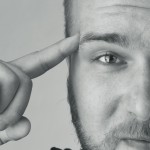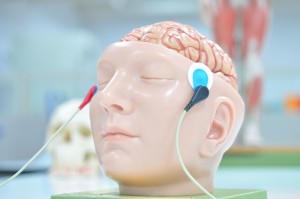
By Kerrie-Anne Ho and Colleen Loo from the University of New South Wales, Australia.
Around 350 million people worldwide have depression. Antidepressant medications are often prescribed to treat the condition, alongside talking therapies and lifestyle changes such as regular exercise.
But a substantial proportion of people either don’t respond to antidepressants, or experience such significant side effects that they’d prefer not to take them.
In search of alternative solutions, researchers around the world, including our team, are investigating transcranial direct current stimulation (TDCS) as an alternative treatment for depression. But this isn’t something you can safely try at home.
Unlike electroconvulsive therapy, TDCS uses very mild electric current to stimulate the brain and has few side effects. The mechanics of TDCS are quite simple, involving a battery, two leads and the electrodes through which the current is passed.

Researchers are yet to fully understand the effects of varying stimulation approaches.
Transcranial Direct Current Stimulation for Depression: how does it work?
The stimulation works by changing the activity of nerve cells in the brain. In depression, the left frontal areas of the brain are often less active than usual. TDCS stimulates this area to restore brain activity.
We’re still evaluating the effectiveness of TDCS, but so far studies have found that TDCS works better than a placebo (or simulated treatment) at reducing symptoms of depression (Kale et al, 2012; Loo et al, 2012).
When combined with the antidepressant medication sertraline (marketed as Zoloft in Australia), the combination TDCS-drug therapy works better than medication or TDCS alone (Brunoni et al, 2013).
Research has found that among people with depression, a course of TDCS can improve the brain’s “neuroplasticity”, which is the brain’s ability to learn and adapt to changes in the environment (Player et al, 2014).
The therapy has a good safety profile; if administered by clinicians and researchers trained in stimulation technique and safety. Our research team has administered thousands of TDCS sessions without incident.
But this is not the case when TDCS is used in the “DIY” context, with DIY users trying to stimulate their own brains.
This phenomenon is often guided by online forums and websites dedicated to DIY TDCS. Users comment on their own experience and share tips on how TDCS can be used to treat their own depression. People with no medical training and limited understanding of TDCS self-treat their depression and advise others on treatment.

Stronger is not necessarily better. Ian Ruotsala/Flickr, CC BY-NC-SA
So, what can go wrong?
The most obvious concern is that poor technique and improper electrode placement could cause skin burns.
What’s more concerning is the ability for TDCS to produce lasting changes in brain functioning. Depending on how TDCS is given, these changes could be good or bad.
A DIY user could, for example, cause lasting impairment to their thinking and memory. For people with severe depression, incorrect application could worsen their condition or induce a hypomanic (manic) episode (Arul-Anandam AP et al, 2010).
When it comes to medications, it’s important to get the right dose and dosing schedule. That’s why this role falls to qualified clinicians and researchers. The same goes for TDCS: current intensity, electrode size and position, and the duration and frequency of the stimulation determine the effects in the brain.
The relationship (Batsikadze et al, 2013) between dosing, intensity and position is highly complex (Bastani et al, 2013a; Bastani et al, 2013b). This isn’t a simple case of “the stronger the better”. Even researchers are yet to fully understand the effects of varying stimulation approaches and much more research is needed.
As with other forms of treatment, TDCS is not suitable for everyone. In clinical research trials, participants are screened for suitability to receive stimulation and their likelihood of responding to treatment. The stimulation is carefully controlled and the participants’ mood is carefully monitored during and after the course of treatment.

A substantial proportion of people don’t respond to antidepressants, or experience significant side effects. Divine Harvester/Flickr
Cost effective depression treatment without drugs?
TDCS represents a promising future, where simple and cost-effective treatment for depression is possible, without drugs. Researchers worldwide are continuing to study this experimental treatment, which may one day become a conventional treatment for depression.
The acceptance and popularity of TDCS among the general community is encouraging. But TDCS is still experimental and isn’t safe to administer at home. DIY users are not trained in proper technique nor are they trained to identify, prevent or deal with unexpected outcomes.
If you’re interested in participating in our TDCS trials for depression, contact the research team at the Black Dog Institute for more information.
Links
Kale UG, Sexton CE, Loo CK, Ebmeier KP. (2012) Transcranial direct current stimulation in the treatment of major depression: a meta-analysis. Psychol Med. 2012 Sep;42(9):1791-800. doi: 10.1017/S0033291711003059. Epub 2012 Jan 12. [PubMed abstract]
Loo CK, Alonzo A, Martin D, Mitchell PB, Galvez V, Sachdev P. (2012) Transcranial direct current stimulation for depression: 3-week, randomised, sham-controlled trial. Br J Psychiatry. 2012 Jan;200(1):52-9. doi: 10.1192/bjp.bp.111.097634. [PubMed abstract]
Brunoni AR, Valiengo L, Baccaro A, Zanão TA, de Oliveira JF, Goulart A, Boggio PS, Lotufo PA, Benseñor IM, Fregni F. (2013) The sertraline vs. electrical current therapy for treating depression clinical study: results from a factorial, randomized, controlled trial. JAMA Psychiatry. 2013 Apr;70(4):383-91. doi: 10.1001/2013.jamapsychiatry.32. [PubMed abstract]
Player MJ, Taylor JL, Weickert CS, Alonzo A, Sachdev PS, Martin D, Mitchell PB, Loo CK. (2014) Increase in PAS-induced neuroplasticity after a treatment course of transcranial direct current stimulation for depression. J Affect Disord. 2014 Oct;167:140-7. doi: 10.1016/j.jad.2014.05.063. Epub 2014 Jun 6. [PubMed abstract]
Arul-Anandam AP, Loo C, Mitchell P. (2010) Induction of hypomanic episode with transcranial direct current stimulation. J ECT. 2010 Mar;26(1):68-9. doi: 10.1097/YCT.0b013e3181a744bf. [PubMed abstract]
Batsikadze G, Moliadze V, Paulus W, Kuo MF, Nitsche MA. (2013) Partially non-linear stimulation intensity-dependent effects of direct current stimulation on motor cortex excitability in humans. J Physiol. 2013 Apr 1;591(Pt 7):1987-2000. doi: 10.1113/jphysiol.2012.249730. Epub 2013 Jan 21. [PubMed abstract]
Bastani A, Jaberzadeh S. (2013a) a-tDCS differential modulation of corticospinal excitability: the effects of electrode size. Brain Stimul. 2013 Nov;6(6):932-7. doi: 10.1016/j.brs.2013.04.005. Epub 2013 Apr 28. [PubMed abstract]
Bastani A, Jaberzadeh S. (2013b) Differential modulation of corticospinal excitability by different current densities of anodal transcranial direct current stimulation. PLoS One. 2013 Aug 22;8(8):e72254. doi: 10.1371/journal.pone.0072254. eCollection 2013. [PubMed abstract]
This article was originally published on The Conversation.
Read the original article.

RT @Mental_Elf: Brain stimulation offers hope for depression, but don’t try it at home http://t.co/kp6yYvXqTy
Brain stimulation offers hope for depression, but don’t try it at home: Today’s blog is reposted from the exce… http://t.co/sI5DWQ7PF6
Mental Elf: Brain stimulation offers hope for depression, but don’t try it at home http://t.co/fd3RACqzyG
Holly Miller liked this on Facebook.
Don’t miss: Brain stimulation offers hope for depression, but don’t try it at home http://t.co/BvcRGl0C57
Brain stimulation offers hope for depression, but don’t try it at home http://t.co/FlkfWkKWt9
Promising research #crnurse
Transcranial Direct Current Stimulation: cost effective #depression treatment without drugs? http://t.co/BvcRGl0C57 #TDCS
“Brain stimulation offers hope for depression, but don’t try at home” @Mental_Elf http://t.co/lzX7A7jRnp
Princess Sunshyne liked this on Facebook.
Brain stimulation offers hope for depression, but don’t try it at home http://t.co/shLjwmBhhI
Brain stimulation offers hope for depression, but don’t try it at home http://t.co/tcv0buvmXo via @sharethis
Your Brain Health liked this on Facebook.
Brain stimulation offers hope for depression, but don’t try it at home http://t.co/PZwglCmZyt #brain
[…] Brain stimulation offers hope for depression, but don’t try it at home The Mental Elf (Kerrie-Anne Ho and Colleen Loo) […]